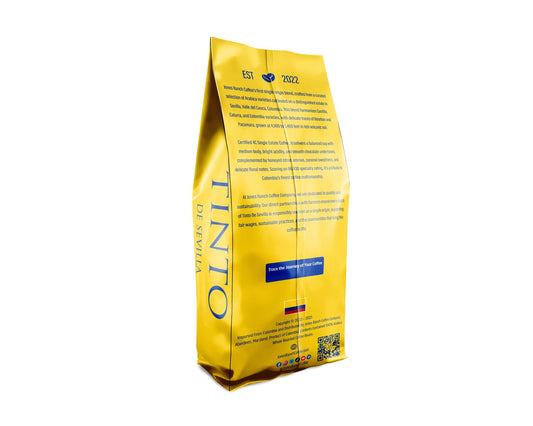Growing Coffee in Colombia
Colombia, renowned globally for its coffee, boasts a rich history intertwined with coffee cultivation that dates back to the early 19th century. Its geography, straddling the equator, offers ideal conditions for coffee growing, with mountainous landscapes, volcanic soils, and a favorable climate contributing to the country's reputation for producing some of the world's finest coffee. Colombian coffee is celebrated for its quality, distinctive flavors, and the meticulous care farmers invest in their cultivation practices.
Types of Beans and Varieties
Colombia primarily cultivates Arabica coffee beans, known for their superior quality, aromatic flavors, and lower caffeine content compared to Robusta beans. Within the Arabica category, Colombia boasts a variety of cultivars, each contributing to the diverse flavor profiles of Colombian coffee:
Flavors
Colombian coffee is renowned for its rich, mild flavor and balanced acidity. Depending on the region, the flavor profiles can range widely:
Fruity and Floral: Coffees from regions like Huila and Nariño often exhibit bright acidity with notes of tropical fruits and floral hints.
Chocolate and Nutty: Beans from Antioquia and Tolima tend to have a sweeter profile with chocolatey undertones and nutty flavors.
Caramel and Citrus: The varied climates of regions like Cauca and Valle del Cauca produce coffees with caramel sweetness and citrus acidity.
Farming Methods
Colombian coffee farming relies on a blend of traditional and innovative practices, ensuring sustainability and quality:
Shade-Grown Coffee: Many farms practice shade-grown coffee cultivation, where coffee plants are grown under the canopy of trees. This method is beneficial for biodiversity, improves soil health, and enhances bean flavor.
Hand-Picking: The majority of coffee in Colombia is picked by hand, ensuring that only ripe cherries are harvested, which contributes to the high quality of the coffee.
Wet Processing: Most Colombian coffee is wet processed (washed), which involves fermenting the beans to remove the mucilage before drying. This method is crucial for developing the coffee's acidity and clean flavors.
Sustainable Practices
Sustainability is a core focus for Jones Ranch Coffee and or Colombian coffee producers, with efforts including:
Water Conservation: Implementing eco-friendly wet processing methods that reduce water usage.
Organic Farming: While not universal, there's a growing trend towards organic farming, avoiding synthetic pesticides and fertilizers to maintain soil health and ecosystem balance.
Fair Trade and Direct Trade: Many Colombian coffee farmers engage in fair trade and direct trade practices, ensuring fair compensation and building strong relationships between producers and consumers.
Sevilla: A Prime Coffee-Growing Region
Nestled in the Valle del Cauca department, Sevilla holds a prestigious place in Colombia's coffee culture. Known as the "Coffee Capital of Colombia," Sevilla's unique microclimate, characterized by ample rainfall and moderate temperatures, creates an optimal environment for coffee cultivation. The region's rich volcanic soil further enhances the coffee's flavor profile, making Sevilla a key contributor to the country's esteemed coffee reputation.
Sevilla: Varieties and Flavors
Colombia predominantly cultivates Arabica coffee, prized for its smooth, mild flavor and aromatic complexity. Sevilla, in particular, is known for producing coffee with a balanced body, bright acidity, and flavors that can range from sweet notes of caramel and chocolate to subtle hints of fruits and nuts, depending on the specific growing conditions and processing methods.
Sevilla: Climate and Farming Practices
Sevilla benefits from a climate that supports year-round coffee production, with a primary harvest season from April to June and a secondary harvest from October to December. Farmers in Sevilla employ traditional and sustainable farming practices, often integrating shade-grown techniques that not only protect the coffee plants from excessive sun but also maintain biodiversity and soil health. Many farms in the region are small, family-owned operations that have passed down their coffee-growing knowledge through generations.
Tourism Sites in Colombia
Beyond its coffee, Colombia offers a wealth of tourism experiences that celebrate its natural beauty, cultural heritage, and adventurous spirit:
Order Single Origin Coffee Today.
-
Pacamara Select Premium Single Origin Coffee (El Salvador)
Vendor:Jones Ranch Coffee Company5.0 / 5.0
(1) 1 total reviews
Regular price $24.00 USDRegular priceUnit price / per -

 Sale
SaleSaludos El Salvador Single Origin Coffee
Vendor:Jones Ranch Coffee Company4.45 / 5.0
(33) 33 total reviews
Regular price $17.00 USDRegular priceUnit price / per$19.00 USDSale price $17.00 USDSale -
Tinto de Sevilla Single Origin Coffee (Colombia)
Vendor:Jones Ranch Coffee CompanyRegular price $18.00 USDRegular priceUnit price / per






